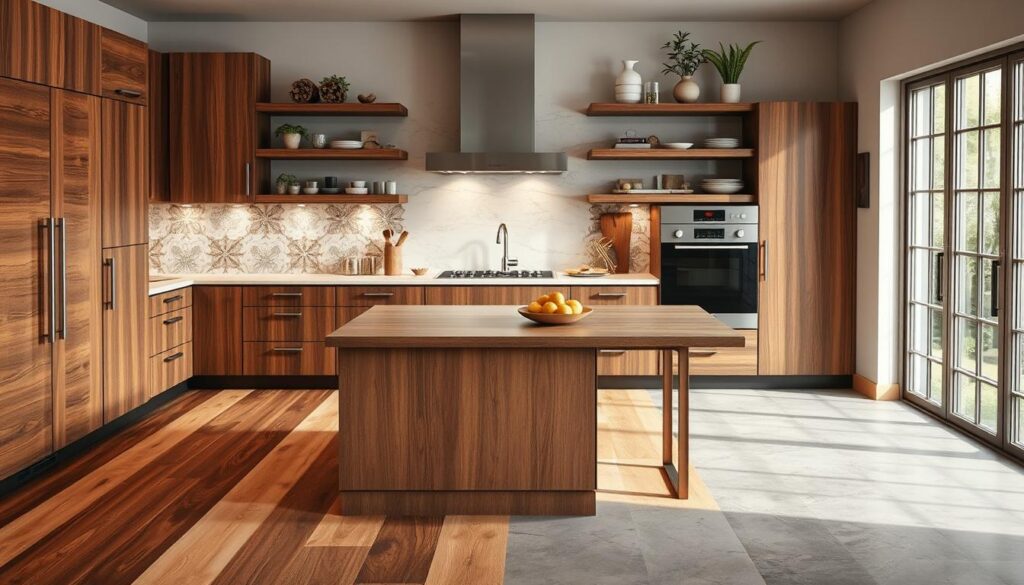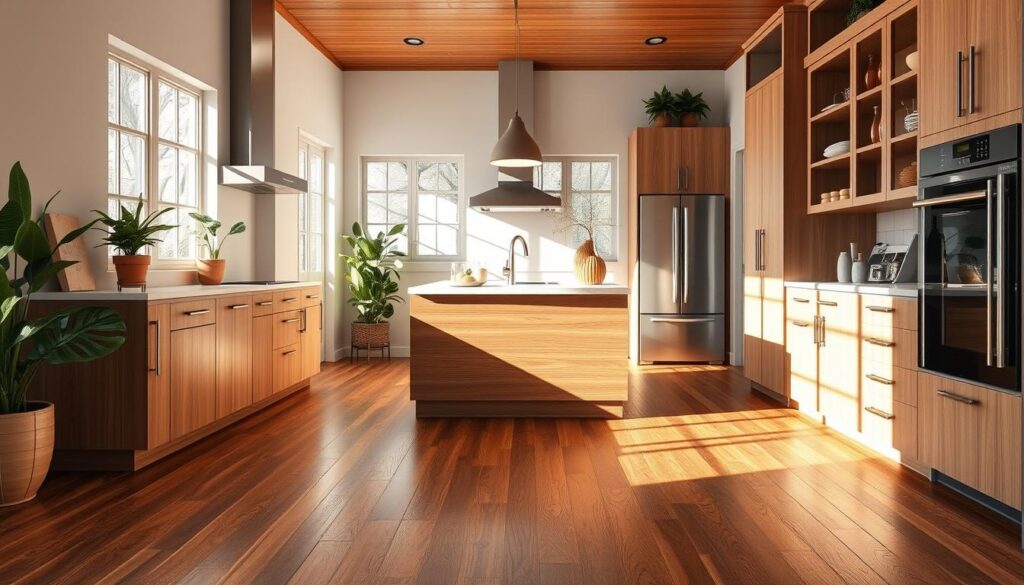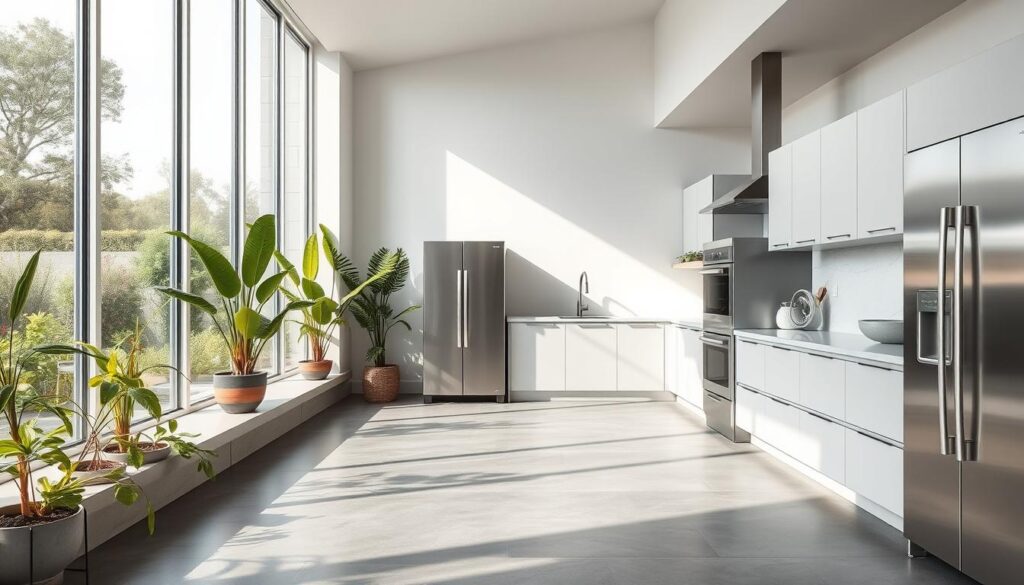Discover the 8 best kitchen flooring options for durability and style. I’ll guide you through the top choices to answer: What is the Best Floor to Change in the Kitchen?
Ever thought about how your kitchen floor affects your home’s look? Choosing the right flooring is key in kitchen renovations. It’s not just about looks; durability and function are just as important. Let’s explore the top kitchen flooring options that are both stylish and practical.
Starting my kitchen renovation, I found the flooring choice was complex. From classic hardwood to modern concrete, each has its pros and cons. It’s vital to think about water resistance, ease of cleaning, and comfort when picking.
In my search for the ideal kitchen floor, I learned that top kitchen remodeling companies offer great advice. They help pick materials that look good and last in a busy kitchen. Whether you want a classic or modern look, there’s a durable and stylish option for you.

Key Takeaways
- Durability is crucial for kitchen flooring
- Water resistance is a key factor to consider
- Style should complement your overall kitchen design
- Budget-friendly options are available without sacrificing quality
- Professional advice can help in making the best choice
- Consider maintenance requirements when selecting flooring
Introduction to Kitchen Flooring: Balancing Style and Functionality
Flooring is key in kitchen design. It’s about finding the right mix of style and function. Kitchens are busy, so floors need to last.
There are many flooring materials, each with its own perks. Let’s explore some favorites:
| Flooring Material | Durability | Style | Maintenance |
|---|---|---|---|
| Ceramic Tile | High | Versatile | Easy |
| Hardwood | Medium | Classic | Moderate |
| Vinyl | High | Varied | Easy |
| Natural Stone | High | Luxurious | Difficult |
In kitchens, where everyone walks by, durability matters. Ceramic tile and vinyl are top picks for lasting well. Hardwood is warm but needs extra care in wet spots.
The right floor can change your kitchen’s vibe. For a modern look, go for sleek porcelain tiles. For a classic feel, hardwood or natural stone is best.
“Your kitchen floor is the foundation of your design. Choose wisely, and it will serve you well for years to come.”
Your kitchen floor should match your design and handle daily use. With the right choice, you’ll have a beautiful, functional space for cooking and gathering.
What is the Best Floor to Change in the Kitchen?
Choosing the right flooring is key in a kitchen remodel. The best floor depends on your needs and lifestyle. Let’s look at what to consider for the perfect kitchen flooring.
Factors to Consider When Choosing Kitchen Flooring
When picking kitchen flooring, think about a few things. Durability is important in busy kitchens. Water resistance helps protect against spills. Comfort is also crucial if you cook a lot.
Durability and Maintenance Requirements
In busy kitchens, durable flooring is a must. Hardwood-style flooring, like in the 715 sq. ft. studio at 1800 Lacassie Ave, Walnut Creek, is durable and stylish. Think about how much maintenance you’re willing to do.
Cost Considerations for Different Flooring Materials
Cost is a big factor in kitchen remodels. Luxury materials like natural stone can increase your home’s value. But, vinyl or laminate can be affordable and stylish. Consider both upfront and long-term costs.
The best kitchen flooring meets your needs and style. Whether it’s hardwood elegance or tile practicality, pick a floor that lasts.
Ceramic and Porcelain Tile: Classic and Versatile Options
I love how ceramic and porcelain tile flooring adds timeless charm to kitchens. They are both stylish and practical, making them a favorite among homeowners. These tiles are durable, easy to clean, and have many designs to match any kitchen style.
Choosing the right slip resistance is key for kitchen floor tiles. Experts say a slip resistance rating of R10 is best. This balance of safety and style is essential for your kitchen.
Tile flooring is also great because it’s water-resistant. This is perfect for kitchens, where spills happen often. Porcelain tile, in particular, is very water-resistant and can handle a lot of foot traffic, ideal for busy kitchens.
When planning a kitchen remodel, consider how your flooring will work with other elements. For example, pairing ceramic or porcelain tiles with quartz countertops is a good idea. But, avoid busy patterns that might clash with the beauty of quartz.
| Tile Type | Water Resistance | Durability | Design Variety |
|---|---|---|---|
| Ceramic | Good | High | Wide Range |
| Porcelain | Excellent | Very High | Extensive |
In my experience, 12″ x 24″ porcelain tiles are a favorite for kitchen floors. They give a sleek, modern look and are simple to keep clean. Whether you want a classic or modern look, tile flooring lets you create your dream kitchen.
Hardwood Flooring: Timeless Beauty for Your Kitchen
Hardwood flooring adds timeless beauty to kitchens. It brings warmth and character to any space. There are two main types: solid hardwood and engineered wood flooring. Each has its own qualities, fitting different kitchen styles.

Solid Hardwood vs. Engineered Wood Flooring
Solid hardwood is a single piece of wood. Engineered wood flooring has layers. Engineered wood is better for kitchens because it’s more moisture-resistant. It’s also easier to install and often cheaper than solid hardwood.

Pros and Cons of Hardwood in Kitchens
Hardwood floors have many benefits:
- They increase your home’s value
- They make your kitchen feel warm and inviting
- They are durable with the right care
- They can be refinished many times
But, there are also downsides:
- They can get damaged by water
- They can scratch or dent
- They need regular maintenance
Maintenance Tips for Wood Floors in High-Traffic Areas
To keep your hardwood floors looking good:
- Clean spills right away
- Use felt pads under furniture
- Sweep or vacuum often
- Avoid wet mopping
With the right care, hardwood floors can last for decades. They are a great investment for your kitchen.
| Cleaning Method | Efficiency Improvement |
|---|---|
| Swiffer with dry cloth for baseboards | 40% reduction in cleaning time |
| Swiffer wet pad for wood floors | 90% fewer dust particles left behind |
Luxury Vinyl Flooring: Affordable and Water-Resistant
I love luxury vinyl flooring for kitchens. It’s a game-changer for homeowners seeking style and practicality. This affordable flooring option mimics pricier materials like hardwood or stone but at a fraction of the cost.
Vinyl flooring shines in high-traffic areas. It’s tough, easy to clean, and stands up to spills. For busy families, this water-resistant flooring is a lifesaver. No need to stress about wet feet or dropped dishes!
Let’s break down the perks of luxury vinyl:
- Durability: Withstands heavy foot traffic
- Water-resistance: Perfect for kitchen spills
- Easy maintenance: Simple to clean and care for
- Comfort: Softer underfoot than tile or stone
- Variety: Wide range of styles and colors
I’ve seen luxury vinyl transform kitchens. In a recent property I viewed at 2330 Uinta Street, Denver, the vinyl siding exterior hinted at the practical choices inside. While this $570,000 home featured carpet and laminate, luxury vinyl would be an excellent upgrade for its 1,496 sq. ft. layout.
| Feature | Luxury Vinyl Flooring |
|---|---|
| Cost Range | $2 – $7 per square foot |
| Lifespan | 10-20 years |
| Installation | DIY-friendly, click-lock system |
| Moisture Resistance | Excellent |
For homeowners balancing budget and style, luxury vinyl flooring is a smart choice. It’s an affordable flooring option that doesn’t skimp on looks or performance.
Natural Stone: Elegant and Long-Lasting Kitchen Floors
Natural stone flooring adds elegance to any kitchen. It’s durable, making it great for busy areas. Many homeowners love it for its timeless beauty and lasting quality.
Popular Stone Options for Kitchen Flooring
There are many natural stone choices for your kitchen. Here are some favorites:
- Marble: Known for its luxurious veining
- Granite: Extremely hard-wearing and heat-resistant
- Slate: Offers a rustic, earthy look
- Travertine: Provides a warm, Mediterranean feel
Caring for Natural Stone Floors
To keep your floors looking great, regular care is essential. Use pH-neutral cleaners and avoid acidic substances. Sealing the stone often helps prevent stains and moisture damage.
Pros and Cons of Stone Flooring in Kitchens
| Pros | Cons |
|---|---|
| Durable and long-lasting | Can be expensive |
| Adds value to your home | Requires regular maintenance |
| Unique, natural patterns | Can be cold underfoot |
| Heat-resistant | Potentially slippery when wet |
Natural stone is a stunning choice for kitchen floors. But, consider your lifestyle and budget. They will help decide if this elegant option fits your home.
Cork Flooring: Eco-Friendly and Comfortable Underfoot
I’m excited to share about cork flooring, a fantastic eco-friendly flooring option for kitchens. This sustainable material offers a unique blend of comfort and environmental consciousness that’s hard to beat.
Cork flooring is incredibly comfortable underfoot, providing a soft surface that’s perfect for those long hours spent cooking or cleaning. It’s also a natural insulator, keeping your kitchen warm in winter and cool in summer.
What makes cork flooring truly stand out is its eco-friendly nature. It’s made from renewable cork bark, which regrows every nine years without harming the tree. This makes it one of the most sustainable materials available for flooring.
- Soft and comfortable underfoot
- Natural insulation properties
- Renewable and biodegradable
- Unique alternative to traditional flooring
Cork flooring is surprisingly affordable, costing between $3 and $7 per square foot. This makes it a budget-friendly choice for those seeking eco-friendly flooring options without breaking the bank.
“Cork flooring combines comfort with sustainability, making it an ideal choice for environmentally conscious homeowners.”
If you’re looking for a kitchen floor that’s kind to your feet and the planet, cork flooring might just be the perfect solution. It’s a choice you can feel good about in more ways than one.
Concrete Floors: Modern and Customizable Kitchen Surfaces

I’ve seen how concrete floors can turn kitchens into stunning, modern spaces. They offer a unique mix of style and practicality. This is why they’ve become so popular lately.
Concrete floors are very versatile. They can be stained, polished, or textured to get different looks. This makes them fit many design styles, from sleek to rustic. I love how they can look like natural stone or wood, making them versatile in modern flooring.
One big plus of concrete floors is their durability. They’re perfect for busy kitchens because they can handle a lot. They’re also easy to care for, needing only occasional resealing to stay looking good.
However, concrete floors have some downsides. They can feel cold, especially in winter. Adding radiant heating helps, but it costs more. Also, getting them installed right is best left to the pros for a flawless finish.
| Aspect | Concrete Floor |
|---|---|
| Durability | Excellent |
| Customization | High |
| Maintenance | Low |
| Installation | Professional recommended |
If you want a flooring option that’s both durable and stylish for your busy kitchen, consider concrete. Its mix of durability and style makes it a top choice for modern kitchens.
Laminate Flooring: Budget-Friendly and Easy to Install
Laminate flooring is a smart choice for those looking to upgrade their kitchen floors without spending a lot. It looks like expensive materials like hardwood or stone but costs less. This makes it perfect for those on a budget.

Advantages of Laminate in Kitchen Environments
Laminate flooring is great for kitchens because it’s tough and easy to clean. It can handle spills and scratches well. Plus, it’s simple to keep clean, saving you time and effort.
Installation Tips for Laminate Kitchen Floors
One of the best things about laminate flooring is how easy it is to put in. Many people choose to do it themselves to save money. Here are some tips to help you install laminate floors successfully:
- Acclimate the flooring to your home’s temperature for 48 hours before installation
- Ensure the subfloor is clean, dry, and level
- Use a moisture barrier in areas prone to dampness
- Leave an expansion gap around the room’s perimeter
Comparing Laminate to Other Flooring Options
When choosing flooring, it’s important to think about different factors. Let’s look at how laminate compares to other popular options:
| Feature | Laminate | Hardwood | Tile |
|---|---|---|---|
| Cost per sq. ft. | $2 – $8 | $6 – $22 | $5 – $15 |
| Durability | Good | Excellent | Excellent |
| Water Resistance | Moderate | Poor | Excellent |
| DIY Installation | Easy | Difficult | Moderate |
Laminate flooring may not last as long as natural stone or hardwood. But its low cost and simple installation make it a popular choice. With the right care, laminate can be a stylish and practical choice for your kitchen for many years.
Conclusion: Choosing the Right Kitchen Flooring for Your Home
Choosing the best flooring for your kitchen is key in any renovation. I’ve looked at many options, each with its benefits. Your kitchen’s look and function depend a lot on your flooring choice.
Think about what you need. Durability, upkeep, and style are important. For example, a historic home might need classic hardwood. But, a modern home could do well with concrete or luxury vinyl.
Also, consider your budget. With home values going up, a good flooring choice can increase your home’s value. Whether you choose timeless tile or trendy cork, pick something that fits your lifestyle and makes your kitchen look great. Happy renovating!
FAQ
What factors should I consider when choosing kitchen flooring?
When picking kitchen flooring, think about durability, upkeep, cost, and style. The material should handle lots of foot traffic, be simple to clean, fit your budget, and match your kitchen’s look.
Is ceramic or porcelain tile better for a kitchen?
Ceramic and porcelain tiles are both great for kitchens. Porcelain is more durable and good with moisture. Ceramic, however, has more styles and colors for design flexibility.
What are the pros and cons of hardwood flooring in a kitchen?
Hardwood floors add timeless beauty and can boost your home’s value. But, they need more care, can get damaged by moisture, and might not last as long as other options. Engineered hardwood is a better choice for moisture resistance.
Is luxury vinyl flooring a good option for kitchens?
Luxury vinyl flooring is affordable and water-resistant for kitchens. It looks like hardwood or stone but is durable and easy to keep up. It’s a smart pick for busy kitchens.
How do I care for natural stone flooring in a kitchen?
Natural stone floors like marble, granite, and slate need regular sealing and cleaning with neutral cleaners. Stay away from harsh cleaners and acidic stuff to avoid damage. Keeping them well-maintained is key to their beauty and life span.
What are the benefits of cork flooring in a kitchen?
Cork flooring is eco-friendly, renewable, and comfy for kitchens. It’s warm and soft, and cushions fall. Plus, it’s good with moisture and easy to care for, making it a unique, green choice.
Can concrete floors be used in a kitchen?
Concrete floors are modern and durable for kitchens. They can be stained, textured, or polished for different looks and are low-maintenance. But, they can be cold without insulation and might need a pro for installation.
Is laminate flooring a good budget-friendly option for kitchens?
Laminate flooring is a budget-friendly option that looks like hardwood or stone. It’s scratch-resistant, easy to put in, and works well in kitchens. It’s not as tough as some, but it’s a cost-effective choice with many designs.








